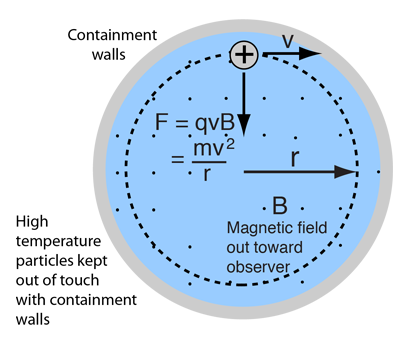Tokamak Fusion Test Reactor
The most well-known of the nuclear fusion test reactors is the TFTR at Princeton. It is a magnetic confinement reactor using the toroidal geometry of the tokamak, a device first developed in the USSR. It operated at Princeton from 1982 to 1997 and made many contributions to the study of nuclear fusion. It uses a combination of two magnetic fields to confine and control the plasma. One is provided by the doughnut-shaped set of external coils which provides a magnetic field along the axis of the the toroid (called the toroidal field). The other is generated by the large heating current along the toroid which heats the plasma; it is called a poloidal field. This heating current is induced by changing magnetic fields in central induction coils and exceeds a million amperes. In addition to the plasma heating by this axial current, the plasma is heated by intense beams of neutral atoms which are injected into the plasma.
In December of 1993 the TFTR produced an output power level of 5.6 million watts in a controlled fusion reaction. While more power than this was required as input to the device, it represents significant progress toward "breakeven", the point at which the output power equals the input power. Progress was also reported at the Joint European Torus (JET) in England, which produced 1.7 million watts of output power in 1991. Under development is the ITER which has the goal of demonstrating the feasibility of energy production by magnetic confinement fusion.
The TFTR reached a temperature of 5.1 x 108 K, above the critical ignition temperature for D-T fusion, and has approached very close to the Lawson criterion, although not at the same time. The temperature reached by the TFTR was the record for highest temperature achieved. It is more than 30 times the core temperature of the Sun, which is about 1.5 x 107 K.
References:
Tokamak Fusion Test Reactor, Princeton
|
